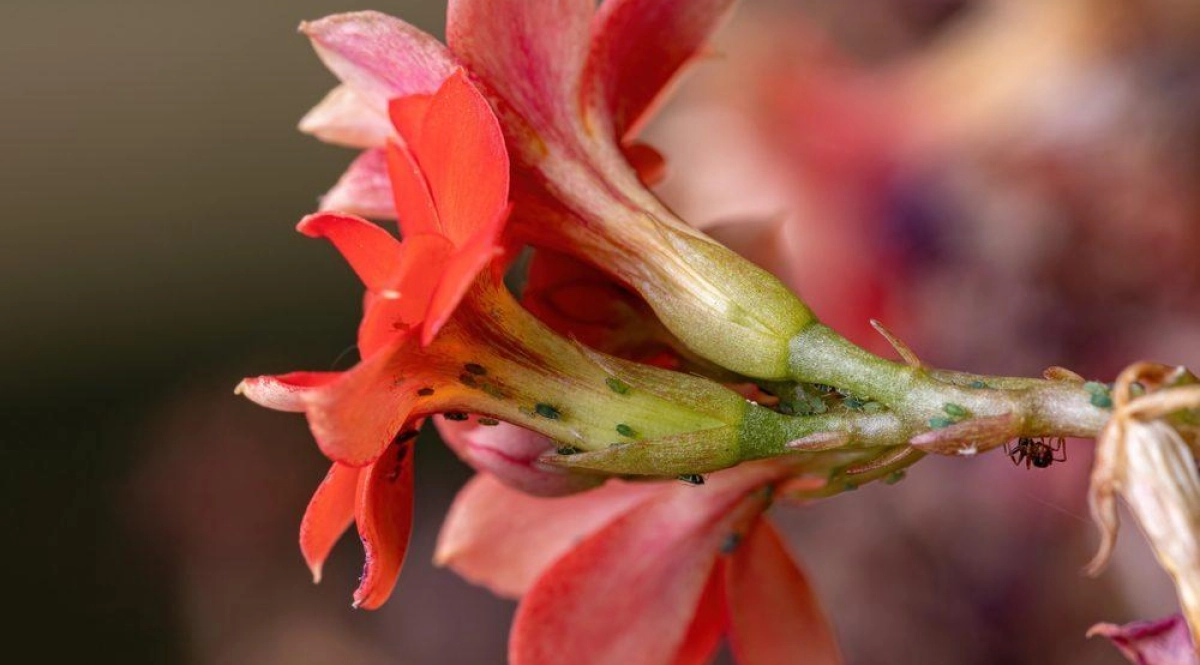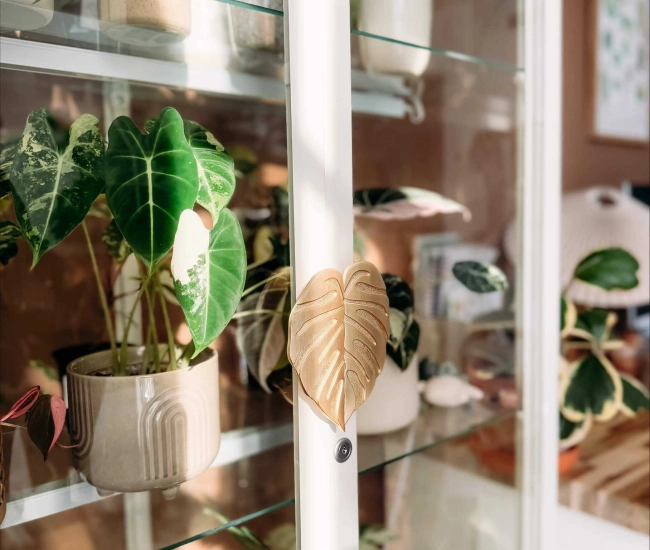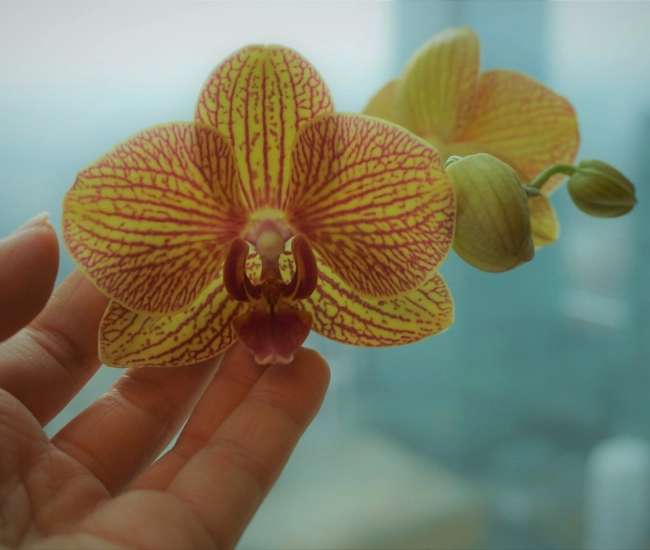
Indoor plants bring life to the decor and add color and vitality to any room. However, they can also introduce unwanted life into your home: insects! Insects can hide in the soil or on the leaves of your plants when purchased, but no plant is safe from an infestation that could be caused by a poorly cleaned gardening tool, an unknowingly contaminated piece of clothing, or even an opening in a window. Often, you won't know the cause of your infestation; what matters is to act quickly to save your precious plants before it's too late. Here are 5 insects to watch out for in your indoor plants:
Spider mites look like small red spiders, and when the infestation is significant, you can easily see the webs they weave with the naked eye. The tiny mites are difficult to see and mainly hide under the leaves. You will see your plant wither and discolor until it becomes translucent.
Spider mites multiply in warm and dry temperatures. Therefore, you must be very vigilant in winter and ensure to increase the humidity level of the environment by misting the foliage or placing your plants on a bed of gravel.
If you are infested, shower your plant and clean it thoroughly with a mild soap. Get some black soap from your local Passion Jardins store and dilute one tablespoon in a liter of water to spray on the plant once or twice a week. Clean the area where your plant is placed to ensure no insects remain that could reinfest your plant.
Fungus gnats are often referred to as soil flies. They closely resemble fruit flies but are much smaller. The flying adults are not harmful, but the larvae cause problems. The tiny larvae feed on the root hairs of plants, slowing their growth and strength.
Make sure to use specialized soil for indoor plants and control watering. Fungus gnats proliferate in constantly damp soil, so let the soil dry well before watering.
If you have a fly problem, get a yellow sticky trap, which you can easily find in garden centers; the flies attracted by the color will stick to it and can no longer lay eggs. Also, replace your soil with new soil, at least the top 5 centimeters, if you don't want to change it completely.
Aphids can have different colors: black, red, yellow, and even green, which are very difficult to spot. These small antennaed insects suck the sap from plants, causing the leaves to dry and wilt. Aphids secrete honeydew, a sticky substance that can promote the growth of a fungus: sooty mold.
To treat aphids, spray a black soap solution (1 tbsp of soap diluted in 1 L of water) 2 to 3 times a week, taking care to rinse the plant with clean water an hour after spraying. You can also find low-impact insecticides at your favorite Passion Jardins garden center; they are quite effective on aphids.
It is said that coffee grounds repel aphids. Sprinkle 1 tablespoon on top of the soil as a preventive measure. After a month, repeat the treatment as the soil will have absorbed the grounds.
Thrips can measure from 1 to 2 millimeters and are thus visible to the naked eye. These insects puncture plants to feed on the contents of their cells. If gray or silver spots and black dots, which are actually thrip excrement, appear on the leaves, you are probably infested.
Thrips like heat and dryness. The best way to keep them away is to increase the ambient humidity by misting the foliage of the plants or placing them on clay balls or a bed of gravel. You can also use a commercial humidifier to humidify the entire room if you wish.
If your plants are infested, you must first get rid of the adults using yellow sticky traps. For the larvae, perform the same black soap treatment as for aphids. Some garden centers are starting to offer predatory insects to control pest infestations. They are quite effective on thrips. Inquire!
Mealybugs are relatively easy to detect: they are covered with white fluff, resembling cotton. They are found at the junction of leaves and stems – the axil – and under the leaves, mainly.
Unfortunately, mealybugs are tenacious, and no insecticide can control them. As soon as you spot an insect, isolate your plant immediately and thoroughly inspect all others. You must then decide if your plant is worth all the work that will follow to get rid of the mealybugs or if it might be better to dispose of it and adopt a new one.
If you want to try, dilute rubbing alcohol in water in a 1:10 ratio and rub all parts of the plant with the mixture, whether infested or not. You will need to repeat the treatment regularly and be very alert for the appearance of a new mealybug.
Healthy plants, well-nourished, properly watered, and placed in the right environment (light, heat, humidity) will be more resistant to insects and diseases. Make sure to give your plants the proper care to keep them at their best and observe them closely to react quickly to any changes. When you bring a new plant home, keep it away from the others for about two weeks to ensure it doesn't bring any unwanted pests with it. This way, you will avoid contaminating your other plants.
Spider Mite
Spider mites look like small red spiders, and when the infestation is significant, you can easily see the webs they weave with the naked eye. The tiny mites are difficult to see and mainly hide under the leaves. You will see your plant wither and discolor until it becomes translucent.
Spider mites multiply in warm and dry temperatures. Therefore, you must be very vigilant in winter and ensure to increase the humidity level of the environment by misting the foliage or placing your plants on a bed of gravel.
If you are infested, shower your plant and clean it thoroughly with a mild soap. Get some black soap from your local Passion Jardins store and dilute one tablespoon in a liter of water to spray on the plant once or twice a week. Clean the area where your plant is placed to ensure no insects remain that could reinfest your plant.
Fungus Gnat
Fungus gnats are often referred to as soil flies. They closely resemble fruit flies but are much smaller. The flying adults are not harmful, but the larvae cause problems. The tiny larvae feed on the root hairs of plants, slowing their growth and strength.
Make sure to use specialized soil for indoor plants and control watering. Fungus gnats proliferate in constantly damp soil, so let the soil dry well before watering.
If you have a fly problem, get a yellow sticky trap, which you can easily find in garden centers; the flies attracted by the color will stick to it and can no longer lay eggs. Also, replace your soil with new soil, at least the top 5 centimeters, if you don't want to change it completely.
Aphid
Aphids can have different colors: black, red, yellow, and even green, which are very difficult to spot. These small antennaed insects suck the sap from plants, causing the leaves to dry and wilt. Aphids secrete honeydew, a sticky substance that can promote the growth of a fungus: sooty mold.
To treat aphids, spray a black soap solution (1 tbsp of soap diluted in 1 L of water) 2 to 3 times a week, taking care to rinse the plant with clean water an hour after spraying. You can also find low-impact insecticides at your favorite Passion Jardins garden center; they are quite effective on aphids.
It is said that coffee grounds repel aphids. Sprinkle 1 tablespoon on top of the soil as a preventive measure. After a month, repeat the treatment as the soil will have absorbed the grounds.
Thrip
Thrips can measure from 1 to 2 millimeters and are thus visible to the naked eye. These insects puncture plants to feed on the contents of their cells. If gray or silver spots and black dots, which are actually thrip excrement, appear on the leaves, you are probably infested.
Thrips like heat and dryness. The best way to keep them away is to increase the ambient humidity by misting the foliage of the plants or placing them on clay balls or a bed of gravel. You can also use a commercial humidifier to humidify the entire room if you wish.
If your plants are infested, you must first get rid of the adults using yellow sticky traps. For the larvae, perform the same black soap treatment as for aphids. Some garden centers are starting to offer predatory insects to control pest infestations. They are quite effective on thrips. Inquire!
Mealybug
Mealybugs are relatively easy to detect: they are covered with white fluff, resembling cotton. They are found at the junction of leaves and stems – the axil – and under the leaves, mainly.
Unfortunately, mealybugs are tenacious, and no insecticide can control them. As soon as you spot an insect, isolate your plant immediately and thoroughly inspect all others. You must then decide if your plant is worth all the work that will follow to get rid of the mealybugs or if it might be better to dispose of it and adopt a new one.
If you want to try, dilute rubbing alcohol in water in a 1:10 ratio and rub all parts of the plant with the mixture, whether infested or not. You will need to repeat the treatment regularly and be very alert for the appearance of a new mealybug.
Prevention is Better than Cure
Healthy plants, well-nourished, properly watered, and placed in the right environment (light, heat, humidity) will be more resistant to insects and diseases. Make sure to give your plants the proper care to keep them at their best and observe them closely to react quickly to any changes. When you bring a new plant home, keep it away from the others for about two weeks to ensure it doesn't bring any unwanted pests with it. This way, you will avoid contaminating your other plants.
Tips and advice



